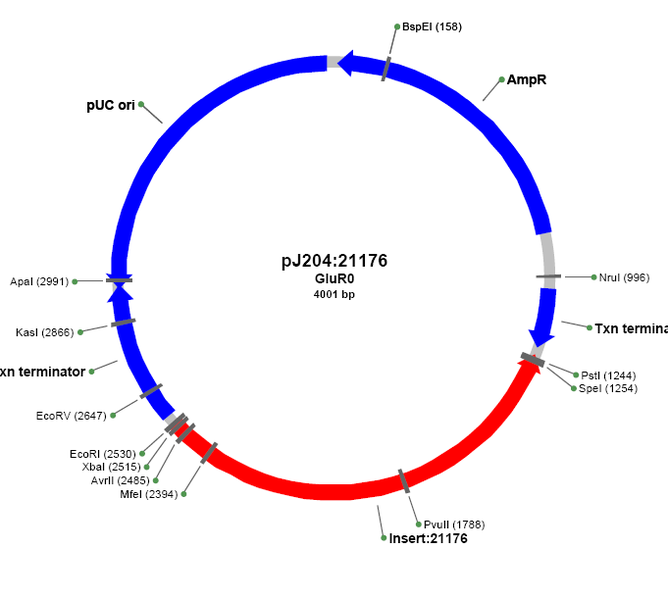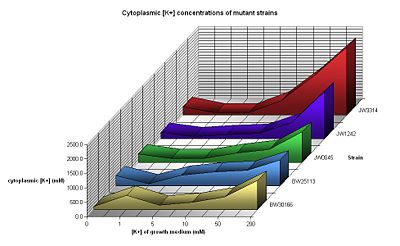Team:Cambridge/Voltage
From 2008.igem.org
|
x
In order to simulate neural activity in bacteria, a mechanism resembling a synapse is necessary. This is the aim of the Voltage section of the Cambridge iBRAIN project. At the synapse, neurotransmitter molecules are released from the presynaptic plasma membrane. The neurotransmitter diffuses through the synaptic cleft and binds to chemical receptor molecules on the membrane of the postsynaptic cell. These receptors cause ion channels to open so that ions rush out, changing the transmembrane potential. Attempting to mimic this in a prokaryotic system is particularly attractive as, in a more general sense, it provides an interface between chemical or biological and electrical systems.
Using the iGEM synthetic biology concept, we identified genes which could contribute to a synapse-like response. We also used a number of existing parts from the registry. To keep the system as simple and therefore feasible as possible the aim was to engineer E.coli to respond to a specific ligand by allowing a flux of ions which would be measurable as a small change in the voltage of the medium the cells are suspended in. The first step was to find prokaryotic ion channels which open in response to a particular molecule or small set of molecules. We searched the [http://www.uniprot.org/ Uniprot database] and found that the organism [http://www.ebi.ac.uk/2can/genomes/bacteria/Synechocystis.html Synechocystis PCC 6803] has a transmembrane protein, GluR0 which is glutamate-gated, and allows flux of potassium ions when opened. We decided to try using the protein coding sequence of the gene for this channel. However, as the sequence came from a different organism, it was necessary to optimise the codons for expression in E.coli. We therefore decided to have the GluRo Biobrick plasmid we had designed synthesised by DNA2.0. Gene Design Using the GluR0 channel defined our ion of interest as potassium. As potassium is a naturally present ion in organisms, E. coli has its own regulatory systems to control its concentration. However, our review of the literature suggested that E. coli only varies potassium concentration as a mechanism of osmoregulation. It has a number of proteins involved in this process including a potassium influx pump (Kdp), a pressure sensitive potassium channel (Kch), and a potassium efflux channel (Kef). The idea of being able to measure a change in voltage of the medium brings with it a number of challenges. The number of ions flowing across the membrane should be as high as possible, to produce a signal significantly higher than the noise. This could be achieved by first packing the cells with potassium, so that a large gradient was set up between the inside and the outside of the cell. Then when the GluR0 channels open, potassium ions will suddenly flow down the concentration gradient. In order to build up this gradient in the first place, we planned to over-express the Kdp-ATPase, which would pump potassium into the cell. However, to stop the balance being restored, the potassium channels would need to be absent or disabled. We ordered a variety of mutant E.coli strains with mutations in each of the genes coding for the potassium flux membrane proteins Kdp, Kch and Kef. To examine the behaviour of these mutant strains we grew them in a variety of potassium concentrations and used OD600 readings to measure their growth rates. We also measured internal potassium concentrations using flame photometry. However there was little difference seen between most of the mutants and the control strain although there was highly variable poasium concentration seen in the different growth conditions. We used PCR to copy the Kdp sequence from the E.coli MG1655 genome. As the pump is an ATPase, we did not want it to be expressed during exponential phase as it could stunt growth. We therefore also used PCR to extract the OsmY promoter from Biobricks developed by MIT in 2006. It is a stationary phase promoter, so by putting Kdp under its control, we could postpone its expression until the cells have stopped needing ATP for growth and division. Unfortunately the ligation and expression of the osmY-Kdp construct proved impossible and flame photometry data showed it was unecessary. Instead, we simply grew the E.coli in high K+ concentrations (100mM) and re-suspended them in low [K+] before adding the agonist, glutamate. Transformation of the GluR0 plasmid into the mutant strains mentioned earlier did not work. Instead, we tried transforming into the more traditional expression strain DH5 alpha Z1, with success. Using very sensitive electrodes connected to an amplifier and oscilloscope we have been able to see voltage changes on application of glutamate to the medium.
Literature[http://expasy.org/tools/ Protein prediction tools] [http://www.pubmedcentral.nih.gov/articlerender.fcgi?artid=1214631| Kdp operon diagram] [http://www.jbc.org/cgi/content/abstract/276/13/9590|Kdp plasmid] [http://www.springerlink.com/content/6042632827845551/ The Kdp-ATPase system and its regulation] [http://cgsc.biology.yale.edu/Strain.php?ID=107402 Potential Chassis: Strain JW1242-1] [http://cgsc.biology.yale.edu/Strain.php?ID=107065 Strain JW0710-1] [http://www.ncbi.nlm.nih.gov/pubmed/4942756 Kdp mutant - paper from 1971] [http://www.shigen.nig.ac.jp/WGR/link/link_E.coli_e.html Worldwide E.coli Databases] [http://jb.asm.org/cgi/content/abstract/188/5/1950 Characterisation of kdpD - 2005] [http://jb.asm.org/cgi/content/full/180/19/5102 Investigations on Kdp Operon exp. & flux] [http://dx.doi.org/10.1006/jmbi.2001.4884 Very interesting 2001 paper concerning Glutamate Channels] [http://www.nature.com/nature/journal/v402/n6763/full/402817a0.html 1999 paper on functional characterization of prokaryote Glu Channels] [http://www.ncbi.nlm.nih.gov/entrez/viewer.fcgi?db=nucleotide&val=BA000022 Sequenced Synechocystis PCC 6803 genome] [http://www.ncbi.nlm.nih.gov/entrez/viewer.fcgi?val=47118304&from=1401809&to=1403002&view=gbwithparts Glutamate-gated K+ channel GluR0] [http://redpoll.pharmacy.ualberta.ca/CCDB/cgi-bin/STAT_NEW.cgi| Link to E.coli statistics page (CCDB Database)]
x
|
 "
"

